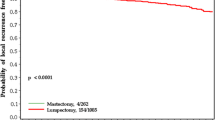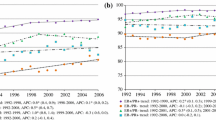Abstract
Background For patients with axillary lymph node-negative breast cancer, benefits from adjuvant therapy are smaller than in node-positive disease and thus more selective use is warranted, prompting development of risk profiling to identify those most likely to benefit. Examination of the magnitude and changes in the hazard of failure over time in node-negative breast cancer may also be informative in this regard. Methods Among 9,444 participants from five randomized trials (accrual 1982–1998) investigating chemotherapy and tamoxifen for node-negative breast cancer, we estimated recurrence hazards over time by tumor estrogen receptor (ER) status and adjuvant treatment. Results In patients treated by surgery only, we observed the previously noted larger hazard peak followed by a rapid decrease in ER-negative patients and smaller but more persistent hazard in ER-positive patients. After approximately 48 months, the ER-positive hazard is greater. For adjuvant treatment, while tamoxifen decreases the early hazard in ER-positive patients to that of the chemotherapy-treated ER-negative group, in later follow-up (beyond 5 years) the hazard for ER-positive patients again exceeds that of ER-negative patients. Adding chemotherapy to tamoxifen in ER-positive patients results in large early hazard reduction, but in later follow-up the hazard converges with those of patients treated by surgery only or tamoxifen. Conclusions Recurrence hazards over time reveal changes in risk that may have biologic and therapeutic strategy relevance. In ER-negative tumors, a large early chemotherapy benefit is followed by a consistently low recurrence hazard over time. In ER-positive patients, the chemotherapy benefit appears concentrated mostly in earlier follow-up, and a greater recurrence risk remains.




Similar content being viewed by others
References
National Institutes of Health Consensus Development Panel (2001) National Institutes of Health Consensus Development Conference statement: adjuvant therapy for breast cancer, November 1–3, 2000. J Natl Cancer Inst Monogr 30:5–15
Early Breast Cancer Trialists’ Collaborative Group (2005) Effects of chemotherapy and hormonal therapy for early breast cancer on recurrence and 15-year survival. Lancet 365:1687–1717
Paik S, Shak S, Tang G et al (2004) A multigene assay to predict recurrence of tamoxifen-treated, node-negative breast cancer. N Engl J Med 351:2817–2826
Paik S, Tang G, Shak S et al (2006) Gene expression and benefit of chemotherapy in women with node-negative, estrogen receptor-positive breast cancer. J Clin Oncol 24:3726–3734
Robbins GF, Berg J (1977) Curability of patients with invasive breast carcinoma based on a 30-year study. World J Surg 1:284–286
Karrison T, Ferguson D, Meier P (1999) Dormancy of mammary carcinoma after mastectomy. J Natl Cancer Inst 91:80–85
Saphner T, Tormey D, Gray R (1996) Annual hazard rates of recurrence for breast cancer after primary therapy. J Clin Oncol 14:2738–2746
Hilsenbeck SG, Ravdin PM, de Moor CA et al (1998) Time-dependence of hazard ratios for prognostic factors in primary breast cancer. Breast Cancer Res Treat 52:227–237
Hess K, Pusztai L, Buzdar A et al (2003) Estrogen receptors and distinct patterns of breast cancer relapse. Breast Cancer Res Treat 78:105–118
Anderson WF, Chen RE, Jatoi I et al (2006) Effect of estrogen receptor expression and histopathology on annual hazard rates of death from breast cancer. Breast Cancer Res Treat 100:121–126
Fisher B, Jeong J-H, Anderson S et al (2004) Treatment of axillary lymph node-negative, estrogen receptor-negative breast cancer: updated findings from National Surgical Adjuvant Breast and Bowel Project clinical trials. J Natl Cancer Inst 96:1823–1831
Fisher B, Jeong J-H, Bryant J et al (2004) Treatment of lymph node-negative, estrogen receptor-positive breast cancer: long-term findings from National Surgical Adjuvant Breast and Bowel Project clinical trials. Lancet 364:858–868
Fisher B, Redmond C, Dimitrov NV et al (1989) A randomized clinical trial evaluating sequential methotrexate and fluorouracil in the treatment of patients with node-negative breast cancer who have estrogen-receptor-negative tumors. N Engl J Med 320:473–478
Fisher B, Dignam J, Mamounas EP et al (1996) Sequential methotrexate and fluorouracil for the treatment of node-negative breast cancer patients with estrogen receptor-negative tumors: eight-year results from National Surgical Adjuvant Breast and Bowel Project (NSABP) B-13 and first report of findings from NSABP B-19 comparing methotrexate and fluorouracil with conventional cyclophosphamide, methotrexate, and fluorouracil. J Clin Oncol 14:1982–1992
Fisher B, Anderson S, Tan-Chiu E et al (2001) Tamoxifen and chemotherapy for axillary node-negative, estrogen receptor-negative breast cancer: findings from National Surgical Adjuvant Breast and Bowel Project B-23. J Clin Oncol 19:931–942
Fisher B, Costantino J, Redmond C et al (1989) A randomized clinical trial evaluating tamoxifen in the treatment of patients with node-negative breast cancer who have estrogen-receptor positive tumors. N Engl J Med 320:479–484
Fisher B, Dignam J, Bryant J et al (1996) Five versus more than five years of tamoxifen for lymph node-negative breast cancer: findings from the National Surgical Adjuvant Breast and Bowel Project B-14 randomized trial. J Natl Cancer Inst 88:1529–1542
Fisher B, Dignam JJ, Wolmark N et al (1997) Tamoxifen and chemotherapy for lymph node-negative, estrogen-receptor positive breast cancer. J Natl Cancer Inst 89:1673–1682
Cox DR (1972) Regression models and life tables. J R Stat Soc B 34:187–220
Prentice RL, Kalbfleisch JD, Peterson AV et al (1978) The analysis of failure times in the presence of competing risks. Biometrics 34:541–554
Kalbfleisch J, Prentice R (1980) The statistical analysis of failure time data. Wiley, New York
Sargent D (1997) A flexible approach to time-varying coefficients in the Cox regression setting. Lifetime Data Anal 3:13–25
Gray RJ (1992) Flexible methods for analyzing survival data using splines, with applications to breast cancer prognosis. J Am Stat Assoc 87:942–951
Hess KR (1994) Assessing time-by-covariate interactions in proportional hazards regression models using cubic spline functions. Stat Med 13:1045–1062
Grambsch PM, Therneau TM, Fleming TR (1995) Diagnostic plots to reveal functional form for covariates in multiplicative intensity models. Biometrics 51:1469–1482
Müller HG, Wang JL (1994) Hazard rates estimation under random censoring with varying kernels and bandwidths. Biometrics 50:61–76
Hess KR, Serachitopol DM, Brown BW (1999) Hazard function estimators: a simulation study. Stat Med 18:3075–3088
Berry DA, Cirrincione C, Henderson IC et al (2006) Estrogen-receptor status and outcomes of modern chemotherapy for patients with node-positive breast cancer. JAMA 295:1658–1667
Cardoso F, Van’t Veer L, Rutgers E et al (2008) Clinical application of the 70-gene profile: the MINDACT trial. J Clin Oncol 26:729–735
Bryant J, Fisher B, Gündüz N et al (1998) S-phase fraction combined with other patient and tumor characteristics for the prognosis of node-negative, estrogen-receptor-positive breast cancer. Breast Cancer Res Treat 51:239–253
Goss PE, Ingle JN, Martino S et al (2005) Randomized trial of letrozole following tamoxifen as extended adjuvant therapy in receptor-positive breast cancer: updated findings from NCIC CTG MA. 17. J Natl Cancer Inst 97:1262–1271
Goss PE, Ingle JN, Pater JL et al (2008) Late extended adjuvant treatment with letrozole improves outcome in women with early-stage breast cancer who complete 5 years of tamoxifen. J Clin Oncol 26:1948–1955
Mamounas EP, Jeong JH, Wickerham DL et al (2008) Benefit from exemestane as extended adjuvant therapy after 5 years of adjuvant tamoxifen: intention-to-treat analysis of the National Surgical Adjuvant Breast and Bowel Project B-33 trial. J Clin Oncol 26:1965–1971
Lin NU, Winer EP (2008) Advances in adjuvant endocrine therapy for postmenopausal women. J Clin Oncol 26:798–805
Aalen O, Gjessing H (2001) Understanding the shape of the hazard rate: a process point of view. Stat Sci 16:1–22
Singpurwulla N (2006) The hazard potential: introduction and overview. J Am Stat Assoc 101:1705–1717
Lawless J (1982) Statistical models and methods for lifetime data. Wiley, New York
Berry D (2005) Breast cancer heterogeneity may explain peaks in recurrence. Int J Surg 3:287
Dignam JJ, Dukic V (2008) Comment on: Yin W Di G, Zhou L et al. Time-varying patterns of recurrence risk for Chinese breast cancer patients. Breast Cancer Res Treat Jun 21 (Epub ahead of print)
Demicheli R, Abbattista A, Miceli R et al (1996) Time distribution of the recurrence risk for breast cancer patients undergoing mastectomy: further support about the concept of tumor dormancy. Breast Cancer Res Treat 41:177–185
Demicheli R, Valagussa P, Bonadonna G (2001) Does surgery modify growth kinetics of breast cancer micrometastases? Br J Cancer 85:490–492
Baum M, Cuzick J, Howell A et al (2005) An exploration of relapse data by hazard rate as a means of developing biological insights into the natural history and treatment of breast cancer. J Clin Oncol. 2005 ASCO annual meeting proceedings, vol 23, No. 16S (June 1 Supplement), p 612
Rastogi P, Anderson SJ, Bear HD et al (2008) Preoperative chemotherapy: updates of National Surgical Adjuvant Breast and Bowel Project Protocols B-18 and B-27. J Clin Oncol 26:778–785
Jeong JH, Jung SH, Wieand S (2003) A parametric model for long-term follow-up data from phase III breast cancer clinical trials. Stat Med 22:339–352
Dukic V, Dignam J (2007) Bayesian hierarchical multiresolution model for the study of time-dependent patterns of failure in early stage breast cancer. Bayesian Anal 2:591–610
Acknowledgments
Supported by a grant from the Susan G. Komen for the Cure Foundation (JJD, VMD) and Public Health Service grants NCI-U10-CA-12027, NCI-U10-CA-69651, NCI-U10-CA-69974, NCI-U10-CA-12027, and NCI P30-CA-14599 from the US National Cancer Institute.
Author information
Authors and Affiliations
Corresponding author
Rights and permissions
About this article
Cite this article
Dignam, J.J., Dukic, V., Anderson, S.J. et al. Hazard of recurrence and adjuvant treatment effects over time in lymph node-negative breast cancer. Breast Cancer Res Treat 116, 595–602 (2009). https://doi.org/10.1007/s10549-008-0200-5
Received:
Accepted:
Published:
Issue Date:
DOI: https://doi.org/10.1007/s10549-008-0200-5




